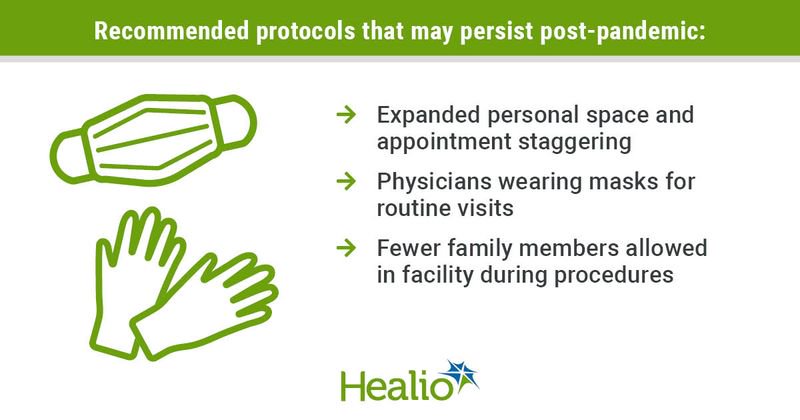COVID-19 practice protocols may remain after pandemic ends
The American Academy of Ophthalmology has helped physicians reduce the risk for SARS-CoV-2 transmission in their practices, and some safety measures may be here to stay.
“At Mass General Brigham hospitals in Boston, nurses in COVID units were no more likely to be infected than in COVID-free units. That is because the protocols we recommended also for ophthalmologists really work,” James Chodosh, MD, MPH, associate director of cornea and refractive surgery service at Mass Eye and Ear and the Edith Ives Cogan professor of ophthalmology at Harvard Medical School, told Healio/OSN.


The protocols outlined on the AAO website include periodic disinfection of high-traffic surfaces, staggered patient schedules and mask policies. In addition, in many places, patients are required to test negative for the virus before any type of procedure.
In some cases, such as severe ocular trauma, a negative test cannot be obtained before treatment. In situations such as this, Chodosh said every physician who encounters the patient should use an N95 mask and protective eyewear.
“I personally think once someone is intubated ... and has been draped and covered, if you can’t wear eye protection, the risk is low at that point. You up the level of personal protection equipment to the degree possible and go forward,” Chodosh said.

Jennifer Loh, MD, said she implemented safety protocols when the pandemic began. In addition to reducing office hours and requiring masks, Loh instituted a temperature check and COVID-19 questionnaire for all patients. She also altered protocols to allow patients to check in for their appointments on their mobile devices.
When an examination room is open, the patient is brought to the room, and traffic throughout the practice is limited. Once the patient is finished, the room is disinfected, Loh said.
Reducing the amount of time a patient spends at the practice is another safety method ophthalmologists have employed throughout the pandemic. Elizabeth Yeu, MD, created a video to explain office procedures and delays. Also, certain follow-up appointments, such as the postoperative day 1 visits from routine cataract surgery, are performed virtually. Patients are given one dose of acetazolamide in postop recovery, and they are also given a topical brimonidine-dorzolamide compounded drop to use for 1 week after surgery.

“When we queried them on how they liked it, 92% said they preferred that over a live visit,” Yeu said.
Taking these extra steps gives patients a sense of comfort. “They know we are ensuring everyone’s safety,” she said.
Over time, patient and physician confidence has increased.
“The drop in confidence is less than there was in the beginning of the pandemic when people were canceling like crazy,” Chodosh said.
“I do get occasional patients — they tend to be more elderly — who are scared to come in, but if they feel like they have to come in, then they let us know they are worried and they don’t want to stay in the office very long,” Loh said.
Practice volume began to rebound last summer, suggesting a growing confidence among patients, and physicians can now look toward the future.
However, there is the possibility that the virus will remain in the population, and patients may be apprehensive to see doctors who are not wearing masks.
“I think there are certain things that will never go back to being the same again,” Yeu said. Expanded personal space and reduced patient volumes are two aspects Yeu thinks will remain.
“I certainly don’t see us actually having family with patients to assist them unless it is absolutely necessary,” she said.
“Even when COVID is not as prominent and more a thing of the past, I will probably still wear a mask at the slit lamp,” Loh said. “I realize now, after wearing a mask, I have actually been healthier since then.”

